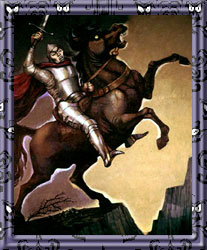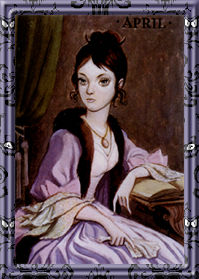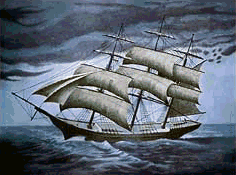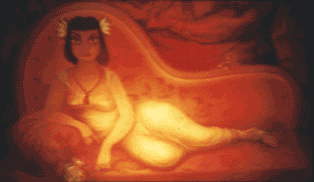 |
|
||||||||||
| |
 |
 |
|
 |
 |
|
|
||||
| |
|
 |
 |
|
|
 |
|
||||
| |
|
||||||||||
| |
|
|
|||||||||
| Welcome, foolish mortals, to my stories page. It's a fun, fictional look at a few of your favorite mystery spooks from Disneyland's Haunted Mansion, starting with everybody's favorite changeable chick - ME! The first set of tales pertains to the changing portraits located in the hall gallery connecting the expanding rooms with the doombuggy load area, which are unique to Disneyland (although, my older half, December, appears in her static, corruptible state, I hear, in the WDW Mansion's "Sinister Eleven" gallery). These stories are unrelated to the wonderful Ghost Gallery already featured online, except for the general "Master Gracey" plotline which WED toyed with back in the day. Stay tuned for new stories...there will always be room for more...any volunteers? If you insist on lagging, you may not need to volunteer! Thanks to Sean for badgering me to flesh out these melodramatic yarns...without his encouragement, they wouldn't be legible. |
|
AprilDecember, how she used to look. Recently, her portrait was moved, and mysteriously, it now appears to be possessed by the spirit of... ...her former husband! [Editor's note - yes, they took her out of the Disneyland Mansion, and replaced her with the WDW 'Master Gracey' changing portrait. The latest news is that the Marc Davis April has resurfaced at the WDW Mansion...not as a changing portrait, however...] |
Portrait Number One: Narcissa Devane Gracey (1840-1922)
The first Mistress Gracey, Narcissa passed her first fifteen years in the sheltered confines of a secluded convent. She was fresh, beautiful, and innocent until her tremendous beauty - and its devastating effects on the opposite sex - became a corrupting influence. With her debut into society at fifteen, she quickly learned that her looks and charm could win her virtually anyone and anything she desired. Though she "settled down" at an early age, marrying a wealthy merchant and self-styled Gentleman Farmer (of the plantation upon which the mansion sits), she had a roving eye (which explains the roguish wink in the "June" portrait) and a loose manner. The Master - hopelessly enraptured by his beautiful yet faithless wife, and fearful that she might reveal to polite society his secret life as a pirate and outlaw - was forced to maintain a front of silent dignity while she caroused with his friends, acquaintances, relatives, and, occasionally, his "help." Ambitious and eager to maintain her stable of admirers, Narcissa became increasingly vain. Each year, she commissioned a new portrait of herself to hang in the mansion's family gallery. She was also responsible for the hanging of several prominently-placed mirrors throughout the mansion, including the ones in the foyer and the corridor of doors. The appearance of these pieces chronicled Narcissa's progressive insensitivity to Gracey's outrage. With time, Narcissa's breathtaking beauty began to fade. As she grew older, fatter, and grayer, the spell she held over her husband waned. As her admirers fell by the wayside, her extramarital resources dwindled, and she became financially and socially dependent on her husband's good graces. Now suffused with newfound power over her, and no longer softened by her beauty, Gracey stood up to his wife. He forbade all extravagances save one - the one he knew would cause her the most pain - her annual tradition of sitting for a portrait in her favorite gown. He made certain that the newest portrait should be hung in a most prominent position, glorifying time's triumph over her evil ways. In time, Narcissa's ugliness made her so distraught that she locked herself away with one of her former lovers, whose superhuman attempts to escape Narcissa's chamber are still evident today in the corridor of bowed, "breathing" doors. She lived for many years thus, never stirring from her self-imposed solitude. By the 1880's, the Master had created a ruse to explain her disappearance, adding her true fate to a growing list of secrets he brought to his second, bigamous marriage to the famous lady who would come to be known as the "Attic Bride." |
| Portrait # 2 - The "Flying Dutchman"
The Master of the Mansion was known to all polite society as a respectable sea merchant. His instant success and tremendous wealth confound many observers and competitors, but his sterling character and spotless reputation dispelled any inclination toward doubt or rumor which may have glimmered at the borders of general consciousness. Near his plantation, along a wide, navigable river (the Mississippi, perhaps? Or the San Joaquin? ;o) ) were situated a modest warehouse and docking facility. This obscure site was known as a holding place for his most private cargoes, and as home to his favorite ship. Unbeknownst to his acquaintances in good society, however, this ship was the prime device of his most vile secret profession - and the mysterious cargoes, the fruits. To put it bluntly, the Master was a pirate in the most horrible sense of the term.
His intended second wife - the unfortunate attic bride - was somehow apprised of the true source of her fiancé's wealth. Some attribute it to her happening upon the Master's mad first wife - Narcissa Devane, as was - one evening while exploring the various rooms and corridors of the strange house. According to this telling, the original Mistress gleefully planted seeds of doubt in the young lady's mind, hoping to revenge her unhappiness and maintain her rightful position as Mistress by setting into motion a most convoluted series of rashly-conceived reactions which she knew would ruin both the Master and his intended. Others blame Madame Leota - the family's friend, confidant, and medium - who, it has been said, wanted the Master and his fortune to herself. In this version of the tale, the ruthless, cunning mystic cast spells and engineered evidence to ensure that the bride would learn the truth and flee in madness. If you subscribe to the latter theory, what comes next proves that Leota grossly underestimated the young lady's will and spirit when mixing her spells. Mortified, the girl found opportunity to confront the Master with her knowledge at the height of a seemingly unrelated row taking place in the attic of the mansion the night before the wedding. The source of this original altercation, it's said, was her loyal friendship with a young man hopelessly and openly enamored by her. Apparently, the young woman was meeting in secret with this friend, a clerk of the town's finest atelier, to receive from him various bits of the wedding ensemble and trousseau. Some also believe that he - either affected by Leota's efforts or in possession of some intelligence wholly gleaned by himself - was taking advantage of this last, poignant opportunity to warn his beloved of the true nature of her fiancé's fortune. Whichever the case, the Master, piqued by the young man's open and honest avowals to his future wife, and incensed by the continued contact made necessary by the faithful lover's career, made it his business to carefully track the clerk's comings and goings. He burst upon them during this final attic meeting, venting his jealousy and demanding that she never see him again. Infused with proud and righteous fury, her worst fears confirmed by a trusted friend, the lady unburdened her understanding of the Master's piracy. Enraged and confused, her savagely strangled her and then proceeded to decapitate her lover, stuffing her body into the trunk containing her wedding clothes and trousseau, and tossing the young man's head into an open hat-box laying amongst the marriage wares. Almost immediately, the Master's rage metamorphosed into crazed grief. Blaming his coconspirators in piracy for his wife's sudden revelations, he lured them all out to sea in that horrid ship, where he then disposed of them all, one by one, by heinous means. He then abandoned ship, returning home to hang himself from the rafters of the Captain's-Walk which topped his mansion. |
| Portrait #3 - The Gorgon
A denizen of ancient Greece, this ghastly creature was the little-known younger half-sister of the three serpent-haired spawns of Poseidon, father of all Gorgons. Her name was Petra. Jealous of their beautiful half-human sibling, the three hideous snake-sisters conspired to make her as horrible as they. Since Petra lived as a human among humans, the beautiful girl knew little about her divine - yet twisted - heritage. And when her sisters appeared to her one day in the temple of Poseidon, she knew not to turn away from them...she looked upon them, and turned to stone! A small temple was erected in her honor, and for a time housed the priests and priestesses of an obscure cult dedicated to the protection of the semi- and quasi- divine living among mortals. Thousands of years later, Master Gracey's Grandfather, a famous classical archaeologist by the name of Dr. Walter Gracey, unwittingly disturbed the remains of Petra's buried shrine while excavating in Greece. He found her stone head in the rubble, and, delighted at the remarkable state of preservation it was in, brought it home to display. He became intrigued with her identity, and devoted his life to the study of her shrine and cult. He was also fascinated by her legend...and her human identity. He even painted a portrait of her as she might have looked, which he hung near her head.
Dr. Gracey spent years in near seclusion, both at the dig site and at home in the United States, preparing a tour-de-force study on Petra and her remains. When he was ready to present his findings to the world, however, her stone visage - the cornerstone of his research - mysteriously disappeared! At this point, Dr. Gracey was largely dismissed as a looney old man. His claims reached far beyond those of an archaeologist, surpassing sense and sanity. He even claimed that the spirit of Petra had appeared to him, reincarnated through the medium of the stone head! How else, he claimed, could he have painted such glowing likeness? At any rate, his stone head missing and his claims and assertions more fantastic than could be believed, the Good Doctor died claiming to have been haunted by Petra's spirit. To this day, family folklore indicates, both sides of her hybrid spirit - human and divine - haunt her only known remaining likeness...this portrait! |
 |
 |
Portrait #4 - The Knight
This knight was crusading with Richard the Lionheart , spending years fighting to capture the Holy Land. When the crusaders were close to capturing Jerusalem, Richard decided to turn back and go home, but the young hotheaded knight swore he would not leave the city in the hands of the enemy. His fellow crusaders tried to dissuade him, but he angered even more as the army filed slowly away. The knight then swore he would take the city himself, and not even the Almighty would stop him. At that instant, a freak bolt of lightning struck the poor crusader, instantly vaporizing his horse and himself, leaving only a pile of ashes. The ashes were scooped up and taken back to Britain, where an artist painted a portrait of the hapless knight, using some of the ashes in the paint mixture. Thus, the spirit of the knight lives on forever on canvas! ~ Rick Reed, former WDW MK Castmember |
| Portrait #5 - Melanie Alexandria Charis (1764 - ?)
Master Gracey's great-grandmother was an avante-garde woman of French and English extraction named Melanie Alexandria Charis. Melanie was the daughter of a French nobleman and an English lady of distinguished birth. She was wealthy and beautiful, but, given the politically incorrect nature of her parentage in eighteenth century France and England, she never truly fit into 'Society' in either nation. She was rarely accepted, and never trusted, in either land. Her only true friend and loyal companion was her black cat, Porphyrion. Melanie became a bit of a rebel, avante-garde in her dress, manner, and interests. She dabbled in witchcraft and various mysterious ancient Greek and Egyptian religious cults. Even after her marriage to a respectable Englishman of the Gracey family - arranged by the grace of her mother's good name and connections - she refused to settle down. She persisted in performing odd ceremonies in secret, which provoked her husband and forced her to hide away in France for a time. At the height of the French Revolution, Melanie's weird theurgies were the subject of much anti-oligarchical speculation and rumor. Sensible people claim that she was either killed or chased into further hiding by revolutionaries, but there are those who claim that the truth is otherwise. They claim that Melanie simply disappeared into the boundless realm of the supernatural one night, as her theurgical rituals went drastically 'wrong.'
|


